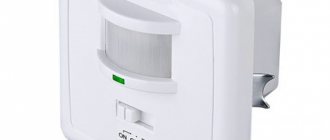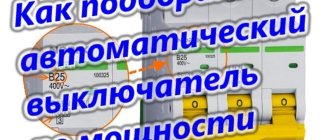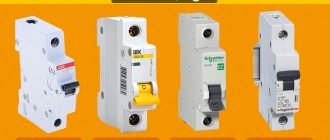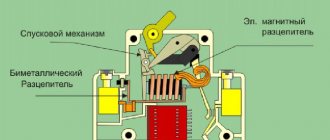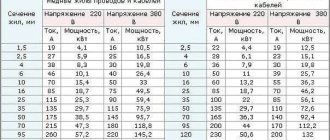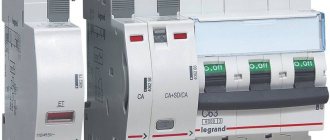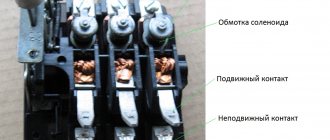Rated current of circuit breaker
The rated current of the circuit breaker is indicated on the front part of the circuit breaker, accessible and clearly visible during operation. The designation of the rated current of a circuit breaker is made by a number, usually following the Latin letter indicating the time-current characteristic of the circuit breaker. The number indicating the rated current of the circuit breaker means that the circuit breaker is designed to protect electrical wiring whose operating current is greater than or equal to the rated current of the circuit breaker.
Parameters of time-current operation of automatic machines (A, B, C and D)
| Designation of protective characteristic (category) | Instantaneous short circuit shutdown (abbreviated) | Preferred Circuit Breaker Application | Loads on the area |
| B | (3-5) In | Protection:
| resistive |
| C | (5-10) In | Protection:
| resistive, inductive with low starting voltage |
| D | (10-50) In | protection:
| inductive with high starting voltage |
Circuit breaker thermal release current
The rated current of the circuit breaker is a parameter that determines the operating current of the thermal release of the circuit breaker. As long as the current flowing in the wiring and through the circuit breaker protecting it is less than the rating of the circuit breaker, nothing happens, however, if the value of the flowing current exceeds the value of the rated current of the circuit breaker, the machine will turn off. The response speed of the circuit breaker, that is, the time after which the circuit breaker opens the power contact, breaks the circuit and turns off the voltage, depends on the time of flow of the excess current and the characteristic curve of the circuit breaker. For example, for a C16 machine, the rated current of which is 16A, and the characteristic curve corresponds to graph C, the machine will turn off when the current in the wiring is equal to 32 amperes, will occur in a period of time from 18 seconds to 150 seconds, and three times the nominal value, that is, the flowing current is equal to 48 Amp., the circuit breaker will turn off in the time range from 4 to 50 seconds, and ten times the rated current for the C16 circuit breaker will lead to it turning off in less than 10 seconds. For each current value, you can calculate the shutdown time of the thermal release using the graph of the time-current characteristics of the machine in question.
Unacceptable mistakes when purchasing
There are several mistakes that novice electricians can make when choosing a circuit breaker based on current strength and load. If you choose an automatic protective device incorrectly, even slightly missing the rating, this can lead to many unfavorable consequences: the circuit breaker will trip when the electrical appliance is turned on, the electrical wiring will not withstand current loads, the service life of the circuit breaker will be quickly reduced, etc.
To prevent this from happening, we recommend that you familiarize yourself with the following errors, which will allow you to choose the right circuit breaker for your home or apartment in the future:
The first and most important thing you should know is that when concluding a contract, new subscribers order the energy capacity of their connection. From this, the technical department makes calculations and selects where the connection will take place and whether the equipment, lines, TP can withstand the load
Also, based on the declared power, the cable cross-section and the rating of the circuit breaker are calculated. For residential subscribers, an unauthorized increase in the input load without upgrading it is unacceptable, since the power has already been declared according to the project and the supply cable has already been laid. In general, the nominal value of the introductory machine is chosen not by you, but by the technical department. If you end up choosing a larger circuit breaker, everything must line up. Always focus not on the power of household appliances, but on the electrical wiring. You should not select a machine only based on the characteristics of electrical appliances if the wiring is old. The danger is that if, for example, to protect an electric stove you choose a 32A model, and the cross-section of the old aluminum cable can only withstand a current of 10A, then your wiring will not withstand it and will quickly melt, which will cause a short circuit in the network. If you need to choose a powerful switching device for protection, first of all replace the electrical wiring in the apartment with a new, more powerful one. If, for example, when calculating the appropriate rating of the machine for the operating current, you came up with an average value between two characteristics - 13.9A (not 10 or 16A), give preference to the larger value only if you know that the wiring will withstand the current load 16A. For a dacha and a garage, it is better to choose a more powerful circuit breaker, because a welding machine, a powerful submersible pump, an asynchronous motor, etc. can be used here. It is better to provide for the connection of powerful consumers in advance, so as not to overpay later on the purchase of a switching device of a higher rating. As a rule, 40A is quite enough to protect the line in domestic use. It is advisable to select all automation from one, high-quality manufacturer. In this case, the likelihood of any discrepancy is minimized. Buy products only in specialized stores, or even better, from an official distributor. In this case, you are unlikely to choose a fake and, moreover, the cost of products from a direct supplier is, as a rule, slightly lower than from intermediaries.
That’s the whole method for choosing the right machine for your own home, apartment or cottage! We hope that now you know how to choose a circuit breaker based on current, load and other equally important characteristics, as well as what mistakes should not be made when purchasing!
How to choose the right rating of the switching device for your home or apartment?
4 ways to check the functionality of an RCD
Connection diagram for differential machine
Show more
Current of the electromagnetic release of the machine
The current flowing through the electromagnetic release of the circuit breaker causes the circuit breaker to turn off when it quickly and significantly exceeds the rated current of the circuit breaker, which usually occurs when there is a short circuit in the protected wiring. A short circuit corresponds to a very quickly increasing high current, which is taken into account by the design of the electromagnetic release, which makes it possible to almost instantly influence the tripping mechanism of the circuit breaker with a rapid increase in the current flowing through the release solenoid coil. The response speed of the electromagnetic release is less than 0.05 seconds.
Criteria for selecting a three-phase switch
Before purchasing, it is worth considering all the parameters that the input device will have.
Leakage current
The body is marked with the Greek letter “delta”. The current leakage of a private house is about 350 mA, of a separate group of devices - 30 mA, lamps and sockets - 30 mA, single links - 15 mA, boiler - 10 mA.
Varieties by current
The machine has indexes A (triggered by DC leakage) and AC (triggered by AC leakage).
Number of poles
Single-pole circuit breaker is used for one phase
Depending on the number of poles, you can purchase a three-phase switch:
- single-pole type of devices for protecting one cable and one phase;
- two-pole, represented by two devices with a common switch - switching off occurs when the permissible value of one of them is exceeded, at the same time the neutral and phase in a single-phase network are cut off;
- a three-pole device that provides interruption and protection of the phase circuit - they are three devices with a common activation/deactivation handle;
- a four-pole device, which is mounted only on the input of a three-phase switchgear, breaks all three phases and the working zero. Breaking the grounding of the protection is unacceptable.
Installation location
For domestic use, a 3-phase electric circuit breaker marked C is intended for 25 A. In this case, it is better to install products C50, C65, C85, C95 at the input. For sockets or other points - C 25 and C 15, for lighting - C 12 or C 17, for an electric stove - C 40. They will operate when the current readings are 5-10 times higher than the nominal value.
Circuit breaker current limit
The circuit breaker current limit is the maximum electric current that can be switched off by the circuit breaker. The current limit of the circuit breaker is also called PKS and is indicated in the markings on the front surface. The marking of the maximum current of the circuit breaker can be indicated in amperes, designated as 3000, 4500, 6000 or 10000, while the figure of the maximum current of the circuit breaker is indicated in a rectangle, without indicating the dimension.
Due to the lack of dimension, the number in the rectangle is sometimes perceived incorrectly and is interpreted as, for example: the permissible number of switches on and off of the machine, the guaranteed number of operations, and other incorrect options.
The current limit of a circuit breaker determines the use of such a circuit breaker depending on the maximum possible short circuit current that can occur in the protected electrical wiring. For most household electrical installations, a PKS of 4500 Amps is quite sufficient, since the state of household electrical networks does not allow the short circuit current to exceed a value of 3000 - 4000 amperes, however, in some cases of short circuits, a current exceeding 4500 amperes can flow through the circuit breaker. In the case of using a 4.5kA circuit breaker, with such an excess of current, the circuit breaker will not be able to turn off the power, since the contact group, under the influence of such a high current, will overheat and weld - burn. The mechanical force stored in the release mechanism is not enough to tear the welded contacts away from each other and the machine will not turn off the power, maintaining the short-circuit current, which will lead, at best, to melting and damage to the wiring, and at worst, to a fire.
Shutdown
Disconnection can occur without a time delay or with a delay. Based on their own shutdown time tc, o (the interval from the moment when the controlled parameter exceeds the value set for it until the moment the contacts begin to diverge), normal switches are distinguished (tc, o = 0.02-1 s), time-delay switches (selective) and high-speed switches (tc, o < 0.005 s).
Normal and selective circuit breakers do not have a current-limiting effect. High-speed switches, like fuses, have a current-limiting effect, since they turn off the circuit before the current in it reaches the value Iy.
Selective circuit breakers allow for selective protection of networks by installing circuit breakers with different time delays: the smallest at the consumer and increasing stepwise towards the power source.
Characteristics
Instantaneous trip current
According to GOST R 50345-2010 (clause 5.3.5), household
circuit
breakers are divided into the following types (classes) based on instantaneous tripping current:
- type B
: over 3
In
up to 5
In
inclusive (where
In
is the rated current) (used to protect lighting lines or long-distance lines) - type C
: over 5
In
up to 10
In
inclusive (used to protect socket groups or lines with consumers with moderate inrush currents) - type D
: over 10
In
up to 20
In
inclusive (used to protect transformers or lines with consumers with high inrush currents)
Industrial circuit breakers can be of the following types:
- type L
: over 8
In - type Z
: over 4
In - type K
: over 12
In
For European manufacturers, the classification may be slightly different. In particular, there is an additional type A
(over 2·
In
to 3·
In
).
At ABB
There are circuit breakers with curves
K
(8 - 14
In
) and Z (2 - 4
In
) corresponding to the IEC 60947-2 standard.
The characteristics of switches are checked during type tests (marking resistance; reliability of screws, conductive parts and connections; reliability of terminals for external conductors; protection against electrical shocks; electrical insulating devices; temperature rise (28-day test); tripping characteristics; mechanical and switching wear resistance; short circuit; resistance to mechanical shocks and impacts; heat resistance; resistance to abnormal heat and fire; corrosion resistance).


